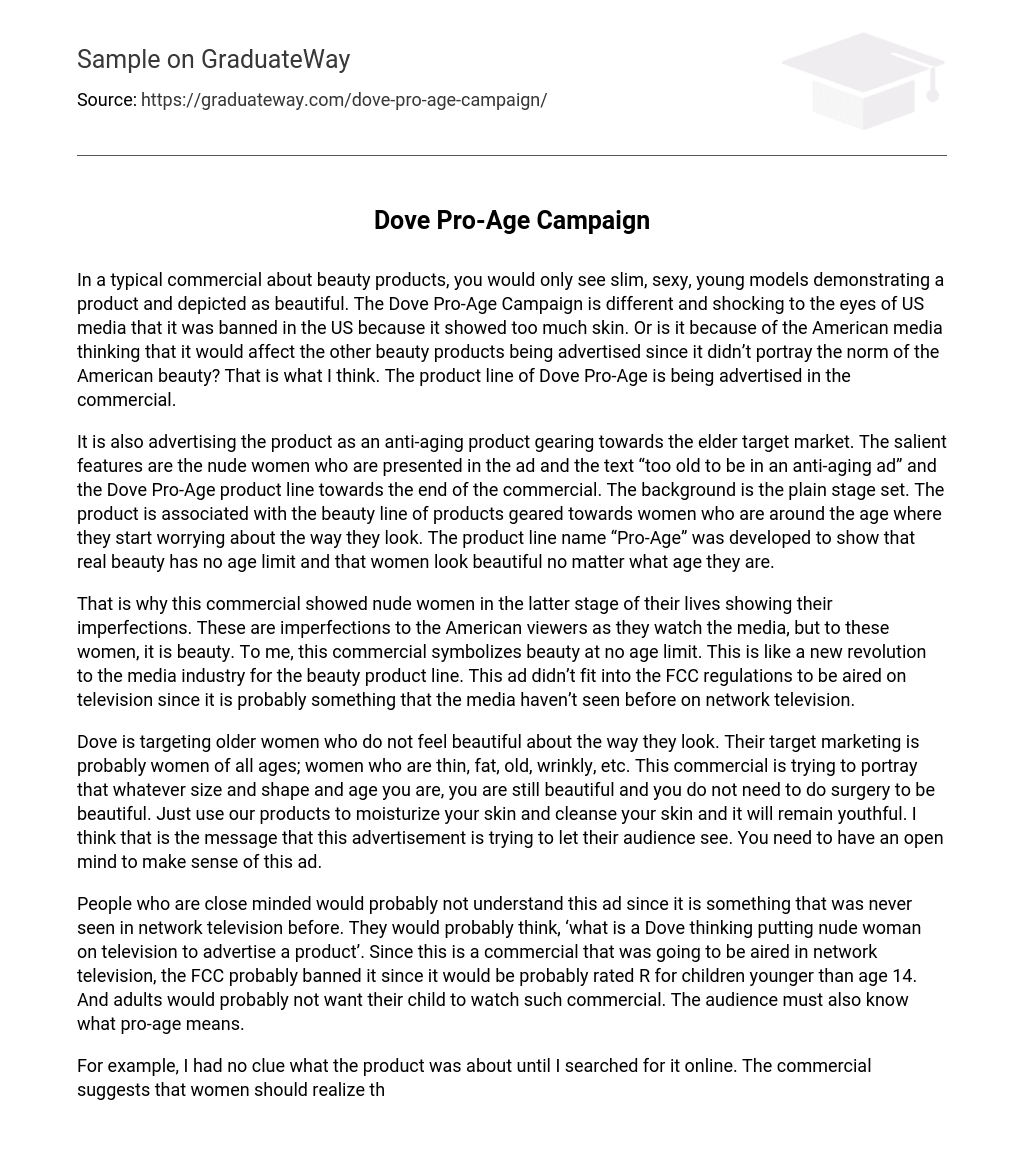The Dove Pro-Age Campaign is different from typical beauty product commercials, which usually only show slim, sexy, young models. In contrast, this campaign attracted a lot of attention from the US media and was even banned for showing too much skin. This decision may have been made because the American media was worried that this alternative portrayal of beauty could affect other products being advertised. However, this is just my personal interpretation. The commercial highlights the range of products offered by Dove Pro-Age.
The advertisement showcases the Dove Pro-Age product line as a solution for mature women concerned about aging. It features nude women and the statement “too old to be in an anti-aging ad”. The plain stage set serves as a backdrop. The name “Pro-Age” highlights the concept that true beauty goes beyond age, emphasizing that women can look beautiful regardless of their age.
The commercial broke FCC regulations by featuring nude older women who proudly displayed their imperfections. While American viewers may perceive these imperfections negatively based on media standards, the women in the commercial view them as beautiful. This advertisement represents a new revolution in the beauty industry, defying age limits. It is likely something that network television has not seen before, explaining why it couldn’t be aired on television.
Dove targets older women who feel unattractive. Their marketing aims to reach women of all body types and ages, including thin, fat, old, or wrinkly individuals. The commercial’s underlying message is that beauty does not depend on size, shape, or age; surgery is unnecessary. Using Dove products for skin moisturization and cleansing helps maintain a youthful look. To grasp the ad’s meaning fully, an open-minded approach is crucial.
Narrow-minded individuals may not understand this advertisement, which introduces a concept never seen on network television. They might wonder why Dove uses naked women to promote their product on TV. Because it is intended for network broadcast, the FCC likely banned it due to potential “R” rating for children under 14. Moreover, adults may choose not to expose their kids to such commercials. Viewers also need to grasp the significance of “pro-age”.
Initially, I had doubts about the product’s purpose upon seeing the commercial. Nevertheless, my online investigation revealed its promotion of the concept that women can possess beauty irrespective of their physical attributes, weight, or age. The advertising campaign places great emphasis on natural beauty and showcases the Pro-Age product as a means to enhance one’s features without relying on Botox or surgery. Dove strives to challenge societal presumptions by altering self-perception and influencing various age and gender groups’ perceptions of women.
Dove launched a worldwide campaign that aired in multiple countries, excluding the US due to adherence to FCC regulations. The campaign aimed to promote the idea of women’s individuality and beauty, regardless of their weight or wrinkles. By boosting women’s self-esteem, Dove sought to emphasize that every woman is unique. The advertisement is clearly advocating for the pro-age product, as reflected in its name. Its main goal is to uplift women who may struggle with low self-esteem regarding their appearance.
The content depicts unattractive nude women who are depicted as models in American media. The ad specifically mentions that these women are too old to be featured in an anti-aging advertisement. However, the purpose of the ad is to promote a product line that focuses on embracing aging and natural beauty. It aims to convey that as women age, they remain beautiful. The commercial raises an important issue regarding how perception is interpreted. Due to its controversial nature, the ad was not aired in the United States but in other international markets. The intention behind Dove’s Pro-Age campaign was to transform how women perceive themselves.
Many women nowadays opt for surgery or Botox in order to enhance their appearance beyond their natural look. The objective of this product line is to demonstrate to women that they don’t require any of these surgeries to be considered valuable and beautiful in society. The US media argued against broadcasting this advertising campaign on network television, claiming it displayed excessive skin, but I believe this is merely a diversion. The media likely doesn’t wish to change the American perception of beauty just yet.
They have not yet caught up with Dove’s revolutionary perspective on beauty, which embraces natural beauty at any age. In American society, the media often portrays beautiful women as slender, tall, and young, as seen in ads for brands like Clean & Clear or Neutrogena. However, Dove is challenging this stereotype by asserting that beauty is not limited by age or size. When viewers see older women in advertisements, they may not immediately associate it with a beauty product but rather with home or medical insurance.
The common perception of women over 50 is the stereotype that Dove aims to challenge with its Pro-Age line of products. Inclusive for all, this line includes body lotion, body cream oil, hand cream, body wash, and beauty bar. Dove’s goal is to redefine their product as suitable for everyone, providing nourishment and revitalization for the skin. Unlike typical product lines like Neutrogena, Dove seeks to differentiate itself by offering something truly unique and ground-breaking in the beauty industry.
Featuring relatable women instead of super models, Dove’s Pro-Age campaign aims to boost women’s confidence and promote self-care using their skin-renewing products. Although the unaired commercial did not make it to television, it has gained significant online publicity through viral marketing. This positive campaign serves to reposition the brand and introduce their new Pro-Age line.





